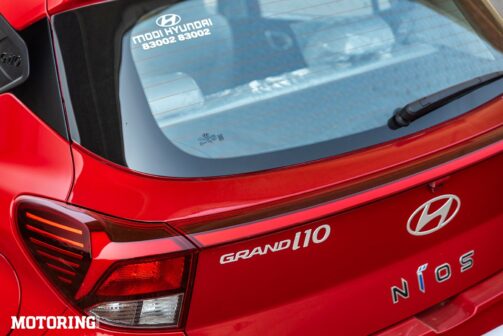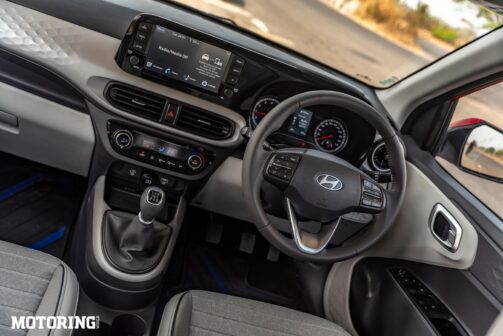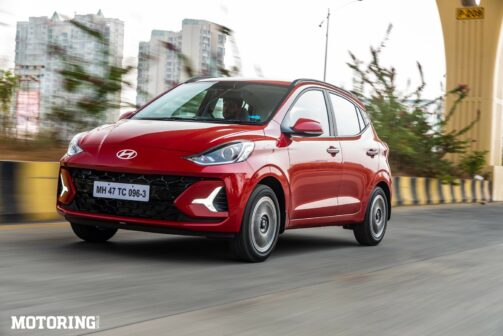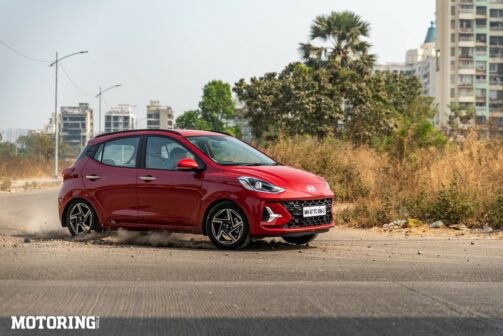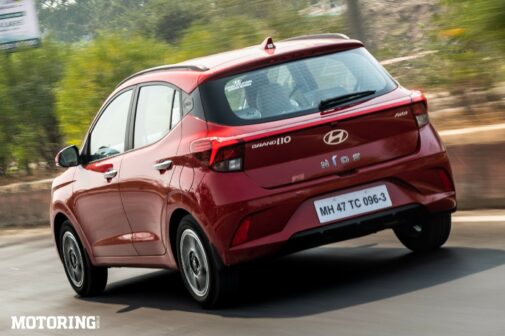The Hyundai Grand i10 Nios has been a staple of the Korean brand’s portfolio in the Indian market, ever since it was first launched as the Grand i10 back in September 2013. Now, the Nios is the most affordable Hyundai car you can buy, but does that mean the entry-level model is no longer worth it? Does the 2023 Nios facelift carry on the legacy created by the now, nearly-venerable Grand i10? We had a day out with the 2023 Hyundai Grand i10 Nios to answer those questions.
It’s somewhat satisfying to see that although the new Nios looks appropriately, well… new, even compared to the pre-facelift model, but still retains the old Grand i10’s silhouette. Hyundai has done quite a good job of hiding what is essentially a tall-boy design, which can only be noticed the the size of the glass house when seen from the side. The major design differentiators include the slimmer automatic projector headlights, arrow-shaped DRLs (no fog light cluster in the revised front bumper), a new grille, and new 15-inch alloys. However, it is the rear of the Grand i10 Nios that really catches the eye — the new LED tail lights and the LED bar that connects them are typically new-age Hyundai, and rather fetching.
It’s a similar story on the inside in terms of living up to its predecessors, though the changes are lesser in number. The dual-tone grey interior theme continues, as does the usual bevy of segment-leading features (which is par for the course for Hyundai) such as the 8.0-inch touchscreen with Android Auto and Apple CarPlay, rear AC vents, automatic climate control, and a wireless charger. However, there’s a new grey upholstery for the seats, a revised instrument cluster with a 3.5-inch MID, and footwell lighting. One other aspect that has been updated is the safety kit — four airbags are standard across the Grand i10 Nios’s range, and top-spec versions also get two more airbags, cruise control, and a tyre pressure monitoring system.
The room and adjustability in the interior hasn’t changed either, which isn’t a bad thing. Four can sit quite comfortably, and the 260-litre boot can take at least one large suitcase and a couple of backpacks. There is ample space for two in the rear bench seat, but thigh support for the larger among us might be lacking, but only over long distances. Thanks to the height adjust for the driver’s seat, finding the best driving position is simple, and the view out is quite good. Special mention needs to be made about the ORVMs — I’ve always been partial to these long units, and they really help visibility, though remember to pull them in (which can be done at a push of a button) when you’re trying to squeeze through a narrow gap.
Mechanically, the Nios facelift is unchanged — you get the same 1.2-litre four-cylinder naturally aspirated mill that is rated at 82 bhp and 11.6 kgm of torque. A 5-speed AMT gearbox is an optional extra, and does add some convenience to the package. However, the 5-speed manual is spectacularly good, for this price point. Shifts are buttery smooth, and the lever slots into any gear with ease. The clutch bite point felt a little off, but that’s been true across a range of new mass-market cars with a manual gearbox. It seems like every manufacturer is looking for that diesel-like ‘just release the clutch and it’ll move forward’ approach. If you use the accelerator slightly, the engine will bog down and stall.
Once on the move, it’s easy to see that most of the potential of this unit has been capped to the bottom end. Revving it above 4000 rpm (which is when peak torque comes in) is more or less a pointless endeavour — the revs rise, and so does the mildly pleasing engine note, but there isn’t that much more forward movement. The Nios is, and has always been a leisurely drive, and quite an efficient one at that. It may not be Maruti Suzuki level, but just below that mark isn’t a bad place to be. A point to also note is that Hyundai says the Nios is RDE compliant, which means there’ll be no need for any mods once April 2023 rolls around.
Ride quality and handling are also the same as before. Most bad roads are taken care of exceedingly well (again for this price point), but that also means there’s more than a decent amount of body roll when you push the Nios hard. The steering weighs up at speed, but there’s no real feedback coming from the electrically-assisted unit. The disc-drum setup (and the ABS and traction control) do a good job of bringing the Nios to a halt effectively. It’s too bad we’re unlikely to see the resurgence of the 99-bhp 1.0-litre turbo-petrol engine with the Nios, but I would advocate for a Nios N Line, with sporty design bits, and that firecracker of a three-cylinder TGDi engine.
The model you see on these pages is the top-spec Nios Asta variant, with a manual gearbox, and it is priced at Rs 7.93 lakh, ex-showroom, Delhi. This means that other than the Maruti Suzuki Swift, the 2023 Nios is the most expensive hatchback in its segment. Still, considering the amount of features on offer, the space, and relative comfort, and the ease of driving, the new Grand i10 Nios is definitely worth looking at closely. It won’t excite you, but it’ll get the job done, and it won’t break the bank while doing it either. I’m still hoping Hyundai India will surprise us with a Nios N Line, which will make it absolutely unique in its class. Fingers crossed.
AUTODATA
Hyundai Grand i10 Nios Asta MTPOWERTRAIN
Displacement:
Max Power:
Max Torque:
Transmission:
1197cc, I4, petrol
82 bhp@6000 rpm
11.6 kgm@4000 rpm
5MT
TYRES
F/R: 175/60 R15
DIMENSIONS
L/W/H (mm):
Wheelbase:
Ground Clearance:
Kerb Weight:
Fuel Capacity:
3815/1680/1520
2450 mm
NA
NA
37 litres
PRICE
Rs 7.93 lakh (ex-showroom, Delhi)











